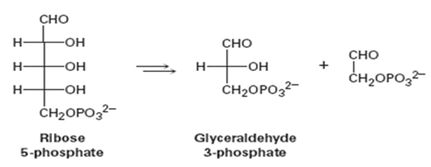
Concept explainers
Interpretation:
The pentose phosphate pathway for degrading sugars (see Problem 29-21) is the conversion of ribose 5-phosphate to glyceraldehyde 3-phosphate.

Concept introduction:
Reactions that make and break C-C-Bonds
Reactions that make and break carbon-carbon bonds form the basis of both degradative and biosynthetic
The breakdown of glucose to CO2 involves give such cleavages where as its synthesis involves the reverse process such reactions, considered from the synthetic direction involve addition of a nucleophilic carbanion to an electrophilic carbon atom. The most common electrophilic carbon atoms in such reactions are the sp2 hybridized carbonyl atoms of

Stabilized carbanions must be generated to add to these electrophilic centres. Three examples are the aldol condensation (catalyzed eg by aldolase) claisen ester condensation (citrate synthase) and the decarboxylation of β-keto acids. (isocitrate dehydrogenase and fatly acid synthase).
Want to see the full answer?
Check out a sample textbook solution
Chapter 29 Solutions
Organic Chemistry - With Access (Custom)
- Briefly indicate the coordination forms of B and Si in borates and silicates, respectively.arrow_forwardCan you please draw out the Lewis structure for these two formulasarrow_forwardIn a rotational Raman spectrum of a diatomic molecule it is correct to say that:a) anti-Stokes lines occur at frequencies higher than the excitatory oneb) Stokes lines occur at frequencies higher than the excitatory onec) Rayleigh scattering is not observedd) Rayleigh scattering corresponds to delta J = 0arrow_forward
- Of the molecules: H2, N2, HCl, CO2, indicate which ones can give Raman vibration-rotation spectra:a) H2, N2 and HClb) H2, N2, HCl and CO2c) H2 and N2d) all of themarrow_forwardCan you please help me with drawing the Lewis structure of each molecular formula?I truly appreciate you!arrow_forwardCan you please help me with drawing the Lewis structure of each molecular formula?I truly appreciate you!arrow_forward
- Describe each highlighted bond in terms of the overlap of atomic orbitals. (a) Н Н H H [References] HIC H H C H H-C-CC-N: H σ character n character (b) HIC H H H H-C-C-C HIC H Н H O-H σ character n character Submit Answer Try Another Version 3 item attempts remainingarrow_forward11 Naming and drawing alcohols Write the systematic (IUPAC) name for each of the following organic molecules: structure OH HO OH Explanation Check name ☐arrow_forwardwhat is the drawn mechanism for diethyl carbonate and 4 - bromo - N, N -dimethylaniline to create crystal violet?arrow_forward

 Introduction to General, Organic and BiochemistryChemistryISBN:9781285869759Author:Frederick A. Bettelheim, William H. Brown, Mary K. Campbell, Shawn O. Farrell, Omar TorresPublisher:Cengage Learning
Introduction to General, Organic and BiochemistryChemistryISBN:9781285869759Author:Frederick A. Bettelheim, William H. Brown, Mary K. Campbell, Shawn O. Farrell, Omar TorresPublisher:Cengage Learning Chemistry In FocusChemistryISBN:9781305084476Author:Tro, Nivaldo J., Neu, Don.Publisher:Cengage Learning
Chemistry In FocusChemistryISBN:9781305084476Author:Tro, Nivaldo J., Neu, Don.Publisher:Cengage Learning Chemistry & Chemical ReactivityChemistryISBN:9781337399074Author:John C. Kotz, Paul M. Treichel, John Townsend, David TreichelPublisher:Cengage Learning
Chemistry & Chemical ReactivityChemistryISBN:9781337399074Author:John C. Kotz, Paul M. Treichel, John Townsend, David TreichelPublisher:Cengage Learning Chemistry & Chemical ReactivityChemistryISBN:9781133949640Author:John C. Kotz, Paul M. Treichel, John Townsend, David TreichelPublisher:Cengage Learning
Chemistry & Chemical ReactivityChemistryISBN:9781133949640Author:John C. Kotz, Paul M. Treichel, John Townsend, David TreichelPublisher:Cengage Learning General, Organic, and Biological ChemistryChemistryISBN:9781285853918Author:H. Stephen StokerPublisher:Cengage Learning
General, Organic, and Biological ChemistryChemistryISBN:9781285853918Author:H. Stephen StokerPublisher:Cengage Learning





